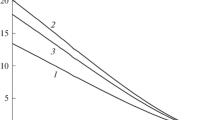Abstract
An approach is formulated that theoretically describes the structure of a rough surface of small aerosol particles obtained from a liquid droplet upon its rapid cooling. The problem consists of two stages. In the first stage, a concentration profile of the droplet–vapor transition region is calculated. In the second stage, local fractions of vacant sites and their pairs are found on the basis of this profile, and the rough structure of a frozen droplet surface transitioning to the solid state is calculated. Model parameters are the temperature of the initial droplet and those of the lateral interaction between droplet atoms. Information on vacant sites inside the region of transition allows us to identify adsorption centers and estimate the monolayer capacity, compared to that of the total space of the region of transition. The approach is oriented toward calculating adsorption isotherms on real surfaces.
Similar content being viewed by others
References
R. Lodiz and R. Parker, The Growth of Single Crystals (Englewood Cliffs, New Jersey, 1987).
F. F. Chernov, E. I. Givargizov, Kh. S. Bagdasarov, L. N. Dem’yanets, V. A. Kuznetsov, and A. N. Lobachev, Modern Crystallography (Nauka, Moscow, 1980; Springer, Berlin, 1984), Vol. 3.
I. V. Melikhov and M. S. Merkulova, Cocrystallization (Nauka, Moscow, 1975) [in Russian].
P. Barret, Cinetique Heterogene (Gauthier-Villars, Paris, 1973).
Yu. K. Tovbin and A. B. Rabinovich, Russ. Chem. Bull. 59, 677 (2010).
Y. Saito and H. Muller-Krumbhaar, J. Chem. Phys. 70, 1078 (1979).
T. A. Cherepanova, J. Cryst. Growth 52, 319 (1981).
Yu. K. Tovbin, Theory of Physicochemical Processes at the Gas–Solid Interface (Nauka, Moscow, 1990) [in Russian].
Yu. K. Tovbin, Prog. Surf. Sci., Nos. 1–4, 1 (1990).
M. K. Wu, Aerosol Sci. Technol. 25, 392 (1996).
Yu. K. Tovbin, Molecular Theory of Adsorption in Porous Bodies (Fizmatlit, Moscow, 2012; CRC, Boca Raton, FL, 2017) [in Russian].
S. Ono and S. Kondo, Molecular Theory of Surface Tension in Liquids (Springer, Berlin, Gottinhen, Heidelberg, 1960).
S. J. Gregg and K. S. W. Sing, Adsorption, Surface Area and Porosity (Academic, London, 1982).
Author information
Authors and Affiliations
Corresponding author
Rights and permissions
About this article
Cite this article
Tovbin, Y.K., Zaitseva, E.S. & Rabinovich, A.B. Simulating the Surface Relief of Nanoaerosols Obtained via the Rapid Cooling of Droplets. Russ. J. Phys. Chem. 92, 587–596 (2018). https://doi.org/10.1134/S0036024418030317
Received:
Published:
Issue Date:
DOI: https://doi.org/10.1134/S0036024418030317




